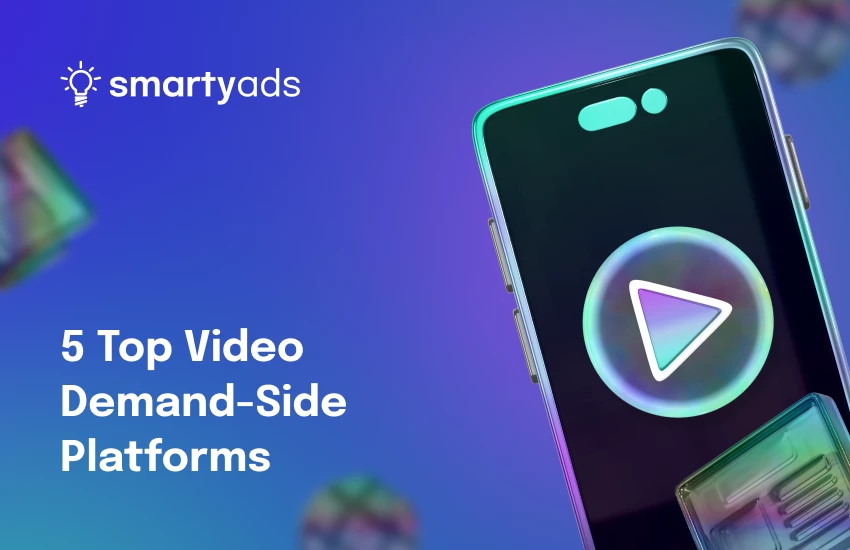DOOH display outdoor advertising has been here ever since customer data started fueling the majority of ad campaigns. The data-driven approach made it possible to display ad content to users while turning the simple OOH (out-of-home) billboards, bus stops, and street furniture into interactive playgrounds (by targeting screens across a wide range of ad networks).
At the same time, we should remember that since DOOH ads are shown in public spaces they will not work precisely like online and mobile ads. The approach to DOOH ads will be completely different from what you're used to and there is a number of reasons for this.
Ad buyers that strive to diversify their media mix and tap into DOOH ad inventory should understand these differences along with the specifics of running programmatic DOOH campaigns.
In this guide, we are going to review: what is DOOH and how it is different from OOH advertising, what is programmatic DOOH campaign and how it is different from a non-programmatic one, and finally, how programmatic DOOH ads should be adjusted for reaching your target audiences and perform just great on DSP.

What is DOOH and how is it different from OOH advertising?
DOOH advertising is basically the process of displaying online ads on digital billboards, interactive bus stops, and street furniture pieces that support interactive ad delivery.
While most online advertising space has been represented by personal devices for a long time, DOOH brought in an opportunity to change the ad play in real-time making the ad experience highly interactive and targeted.
DOOH inventory is represented by many types of digital screens which are usually located in public places where they have the most chances to be seen - shopping malls, trading fairs, music gigs, private airports, healthcare facilities, and even grocery stores or buildings that have in-built digital displays.
So basically DOOH is the same thing as OOH advertising as it takes place outdoors plus with the added component of interactivity and support for targeting.
Industry leaders, big brands, and ad buyers put high hopes on this advertising space since digital OOH is not affected by ad blockers. The DOOH ad has many different benefits but probably the most important of them (that differentiates the DOOH format from other formats) is that no other medium can deliver the ad experience of such effective ad impact.
The ads are normally served on big screens so such ads are very memorable and they elevate brand awareness. Plus, those ads have very good emotional appeal so they create a longstanding relationship with a potential customer.
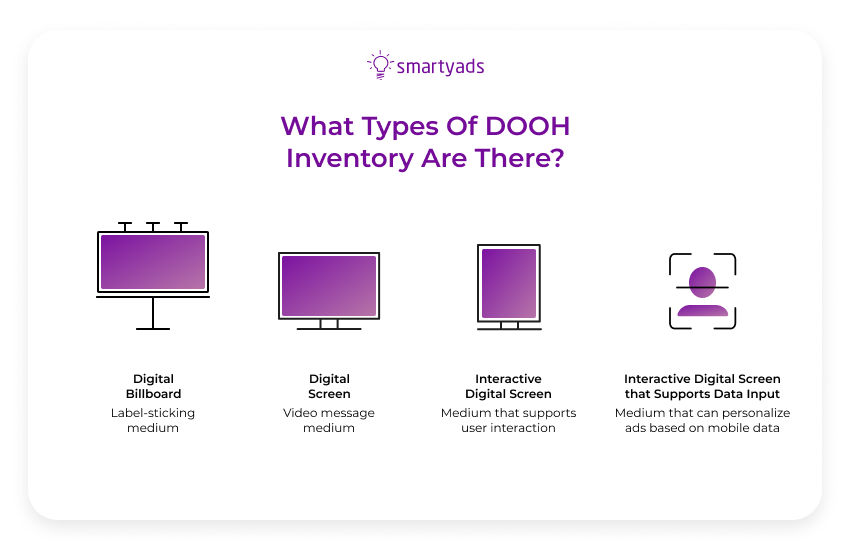
Because of the unparalleled reach, DOOH campaigns are most frequently launched by businesses in such advertising verticals as transportation, restaurants, eCommerce, finance, healthcare, and technology.

What kind of campaigns DOOH is good for?
DOOH is positioned as a high-impact visual ad format that delivers a highly emotional experience to viewers. For this reason, DOOH is considered to be the best form of advertising when you need to achieve better brand awareness and raise purchase intent. In the nutshell, if you look for something really memorable for your branding campaigns, look no further.
What are the advantages of DOOH ads?
DOOH advertising has plenty of strong sides among which are increased campaign effectiveness, safety, and outstanding reach.
Increased campaign effectiveness
Advertising on outdoor digital screens has never been so effective; with this technology, you target the audience outdoors more precisely thanks to the data-driven approach. DOOH in general can utilize location data, audience demographics data, and mobile location data (since many DOOH networks integrate with mobile data providers) as well, DOOH devices normally integrate with multiple networks. DOOH network owners commonly leave certain ad slot shares for programmatic buyers.
Digital display DOOH campaigns are safe
DOOH ad space is fraud-free by design, which can't be said about other channels. The common concern about ad blockers is also invalid here as no blocking tech has been invented so far for digital out-of-home screens (obviously, they are specifically created for ad serving).
Almost 100% greater reach
Both DOOH and traditional OOH advertising can be effective on their own; however, when using (D)OOH in conjunction with other channels, outstanding results can be achieved. Studies show that a cross-media campaign with an OOH component can increase reach by over 100%.
What is programmatic DOOH, and how is it different from simple DOOH?
For starters, it is very important to distinguish the notion of DOOH from programmatic DOOH, although both are served on digital billboards.
With a direct sale, media owners can offer their ad space directly to advertisers, and the digital ad buying process is performed manually (arrangement, transactions, placing, etc).
However, when DOOH campaigns are executed programmatically, it means that ad buying is automated - the system can automatically place bids through a real-time bidding algorithm.
The real-time bidding auction defines the winner and the system assigns the winner's ad to the DOOH ad slot. This is the essence of automated buying.
How programmatic campaigns work in a nutshell
The programmatic ecosystem includes a whole range of data-driven platforms that are interconnected with each other in order to ensure effective inventory purchasing (for advertisers) and monetization (for publishers).
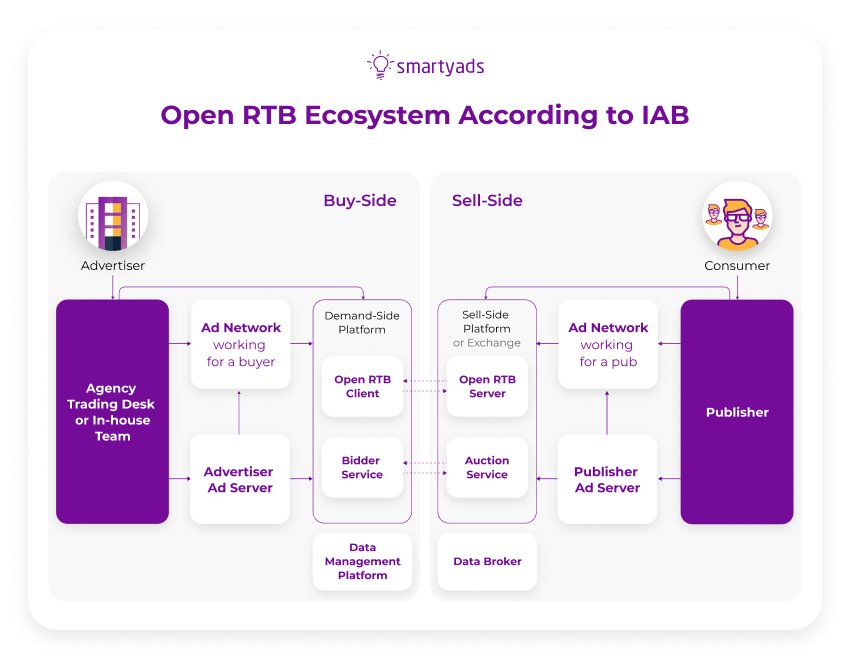
The main point is that supply platforms like SSPs ensure the effectiveness of inventory monetization whereas demand platforms like DSPs ensure that inventory is bought for the best price in the right ad slot.
Before the ad campaign is started, advertisers register at DSP and input necessary campaign data to instruct the system on how the inventory should be bought (according to what criteria).
There are various types of programmatic buys or so-called programmatic deals.
All of those deals bring different advantages to the table so advertisers should familiarize themselves with each one before setting up a campaign.
Here are the main benefits of programmatic DOOH:
- Programmatic transactions usually take less than a millisecond, so typically, neither the media owner nor media buyer deals with the time-consuming ad placement process;
- Ability to utilize first-party data to target audience offline;
- Automated buying saves time for the media owner and the media buyer alike;
- Options to buy programmatic inventory through RTB, PMP (private marketplace), or even guaranteed programmatic deal;
- Mid-campaign optimization. Unlike in traditional placement, with programmatic DOOH, advertisers can optimize campaigns and change their criteria on the go.

Specifics of programmatic DOOH targeting
With simple traditional OOH advertising brands can't target the audience they want. With DOOH it becomes possible thanks to certain targeting triggers.
However, here we should point out - for desktop and mobile campaigns that have individual user screens, targeting for programmatic campaigns has reached an unpreceded precision.
At the same time, targeting DOOH programmatic campaigns is not so advanced since DOOH digital screens are not made for individual usage.
However, even with this programmatic DOOH campaigns can effectively reach specific audiences. For example, a programmatic transaction can happen when certain conditions are met.
What targeting criteria are here?
There are simple conditions, for example, different times of the day. There is a more difficult one like the current weather conditions (e.g. brands can offer an umbrella when it's raining).
Furthermore, brands can repurpose existing content from an online and/or mobile campaign into the programmatic DOOH campaign or use data about daily market performance when available.
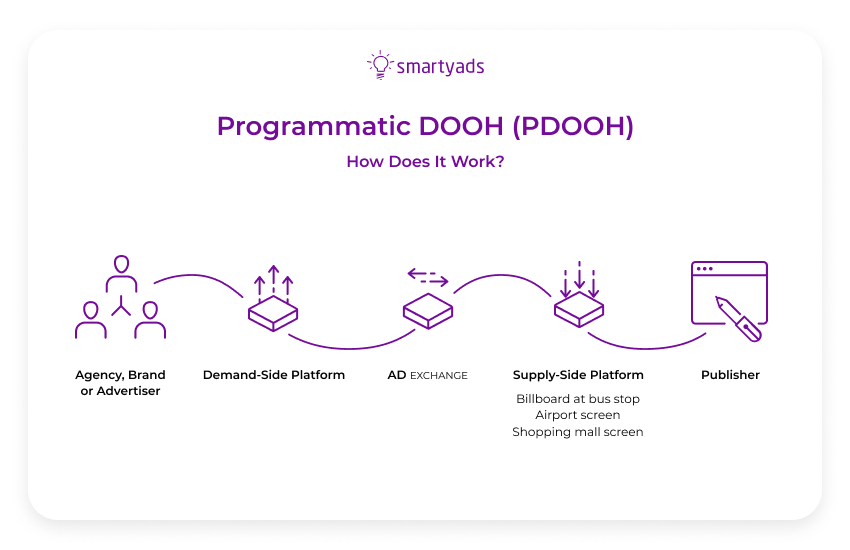
Thus, before adding DOOH campaigns to your media mix, make sure to find out what targeting options your demand-side platform or ad exchange has for this medium.
In fact, according to stats, in 2021, 81% of advertisers were preparing to include DOOH campaigns in their media mix (in 2022).
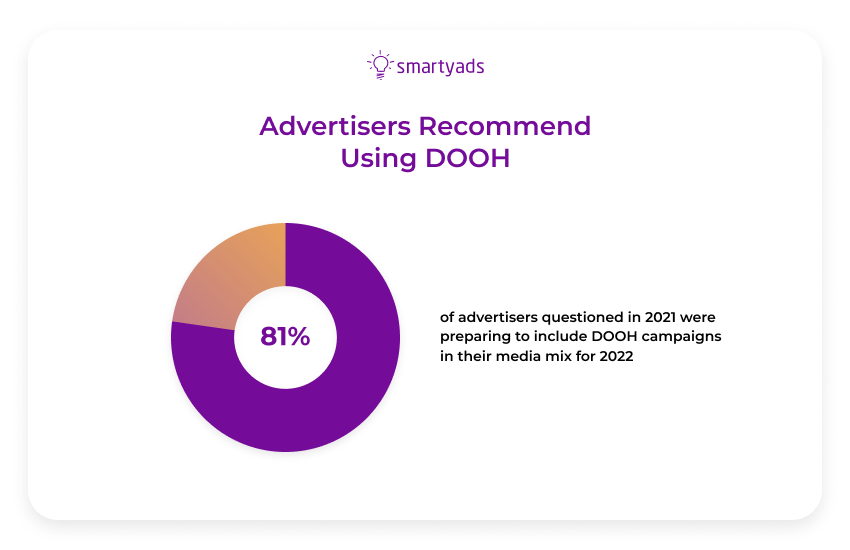
For example, check out how the Foodora brand used location, weather, and time of day data to make the ad message on digital OOH as relevant as possible. This way the ad could easily reach consumers and elevate their purchase intent.
Reasons why programmatic DOOH keeps growing and developing
Generally, if we look at the stats, we can notice that DOOH advertising is progressively growing. Taken that COVID-19 restrictions are slowly loosening all across the globe, soon enough digital out-of-home format will see a new wave of revival.
According to the data for 2021 by HubSpot, the demand for outdoor experiences is already growing.
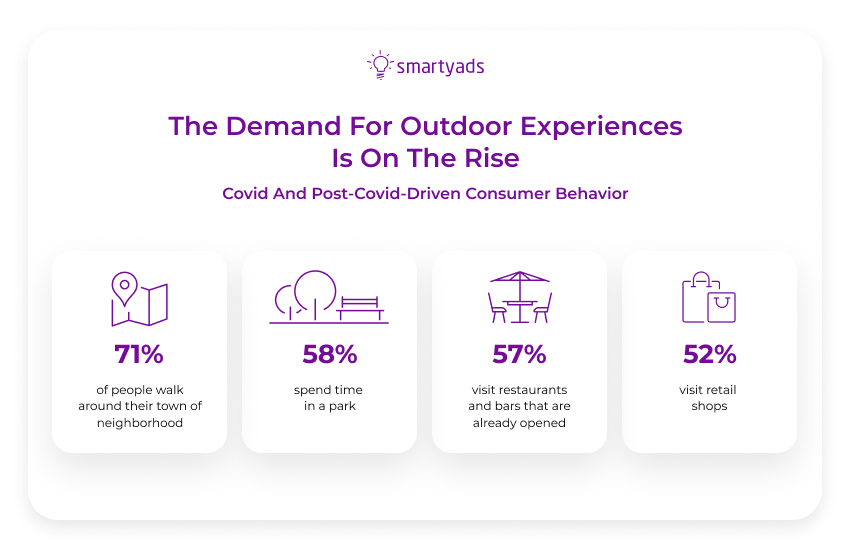
People will go outside more often and brands will seek new opportunities to catch their attention in the offline world.
When 68% of people are experiencing digital device burnout along with banner blindness on personal screens, digital out-of-home displays don't drive such irritation and appear as a more friendly form of advertising.
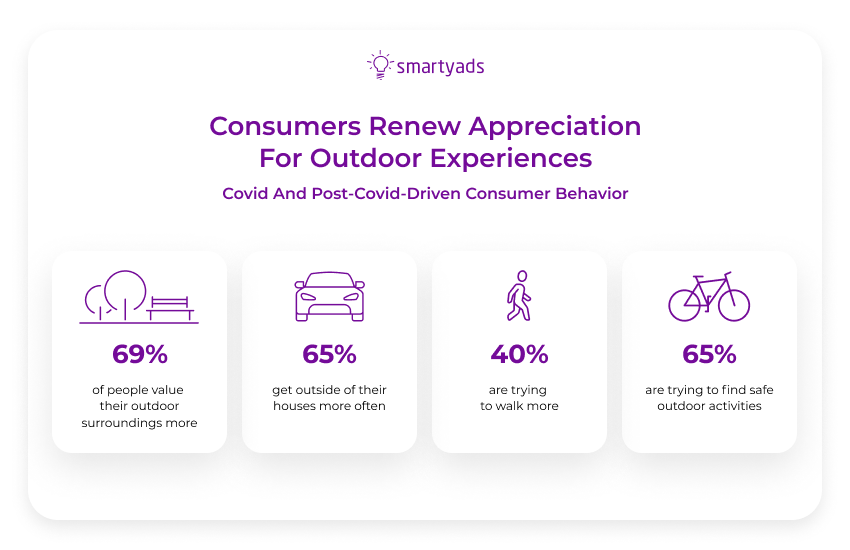
According to the stats for 2021, 52% of street passers-by notice these kinds of ads all the time.

Interestingly enough, 69% of viewers also engage in a certain form of action after watching street-level advertisements like DOOH.
How big is DOOH market?
Experts predict that the time of big trade shows, sporting events, and global exhibitions is back again, so the big time for digital out-of-home advertising is yet to come. As a result, the annual growth rate of DOOH ad spend for 2022-2023 will reach $3.84 billion.
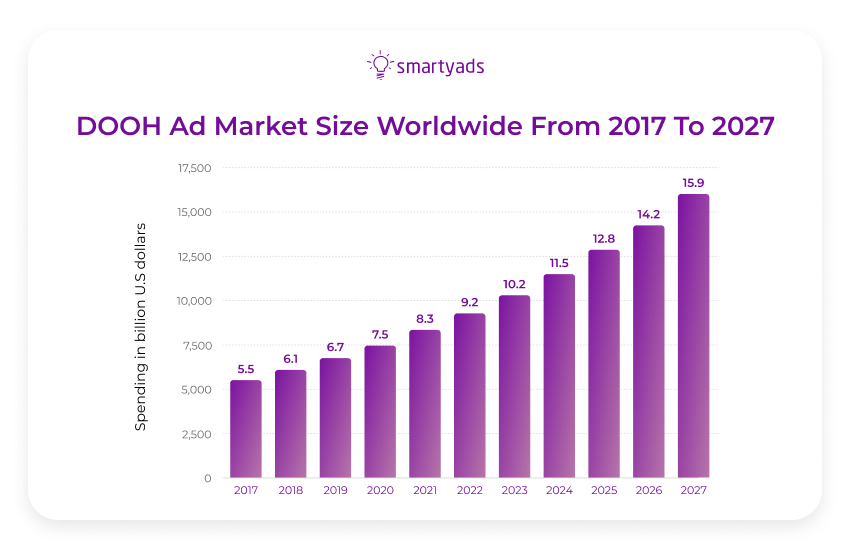
What about DOOH performance?
So, we've already found out that DOOH is best applied for branding campaigns aiming at raising brand awareness. However, as stats report, digital billboards can do even more than that, leading the viewer directly to the purchase decision.
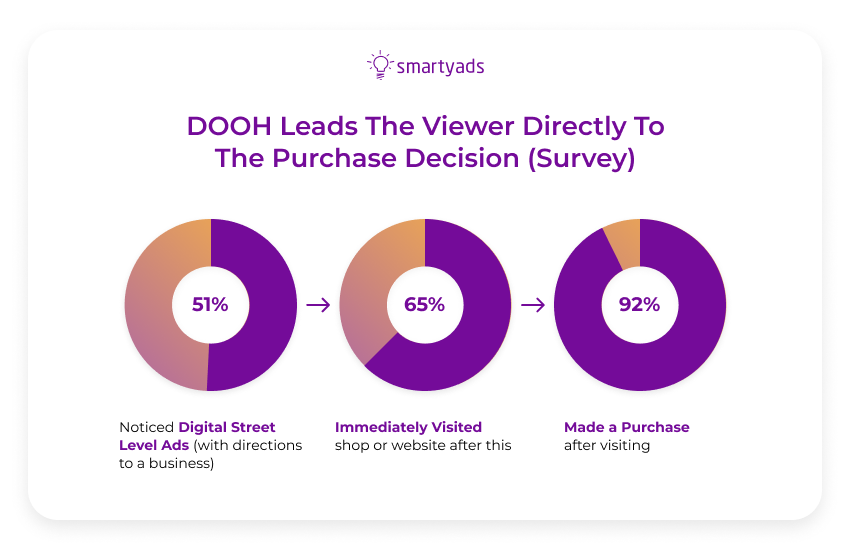
DOOH CPM rates
According to some estimations, the average CPM rate for DOOH falls within the range of $1.50 – $5.21. For comparison, Facebook ads' CPM range hangs at the level of $7.19.
Programmatic DOOH CPM range
Programmatic DOOH CPM range will also heavily depend on several factors like geo where the campaigns are served, placement type, traffic peculiarities, and so on.
Additionally, programmatic buying can't be stable at all times as traffic volumes are fluid so the price for inventory may be lower or higher during certain periods.
How long should a DOOH campaign last?
Digital out-of-home campaigns are usually launched on a weekly basis, with the standard duration of a campaign lasting around 4 weeks. However, with programmatic campaigns, advertisers can launch and run DOOH ads for the time they need - from several days to months and more.
How to launch an effective programmatic DOOH campaign?
The programmatic digital out-of-home campaign is starting with a great demand-side platform because this is exactly what you will need in order to participate in real-time bidding auctions.
The first step you need to take is to make sure that your DSP provides access to DOOH traffic and then proceed to set up your campaign.
Decide on goals
In case your goal is to reach better brand awareness, look for CPM-based programmatic digital platforms. Otherwise, if you want to combine DOOH campaigns with e.g. mobile ones and you want to measure e.g. conversions on mobile, make sure you choose a platform that supports several types of campaigns that you need - CPM, CPC, CPA, CPI, or else.
Define your ad format
Right now, video is the only format that largely prevails on DOOH screens because it can deliver the brand's message with impact and in detail. General recommendations regarding video creative on DOOh include:
- Make your ad message concise; include a 'hook' at the beginning;
- Include a CTA at the end;
- Visuals should be clear and bright in color but not too complicated to understand.
Choose the right timing
Your programmatic DOOH advertising units should appear on the screen when they are most likely to be noticed by users.
For example, if you know that your target audience is most active e.g. during the evening hours (or your product is bought during the evening hours), you can adjust the campaign timing and dayparting accordingly.
Creating a programmatic DOOH campaign on SmartyAds DSP
Creating a programmatic campaign on SmartyAds DSP is very easy. As you probably know, recently, SmartyAds introduced DOOH and audio capabilities, so advertisers can already benefit from high-impact DOOH campaigns.
There are several steps you should follow. Register at SmartyAds DSP and fill out the budget.
1) Create your video campaign
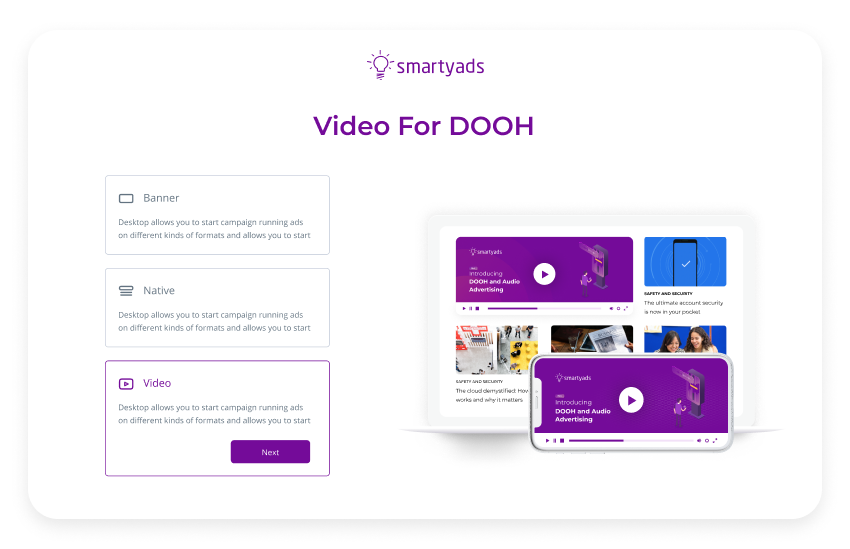
2) Fill out the campaign settings and activate DOOH traffic type
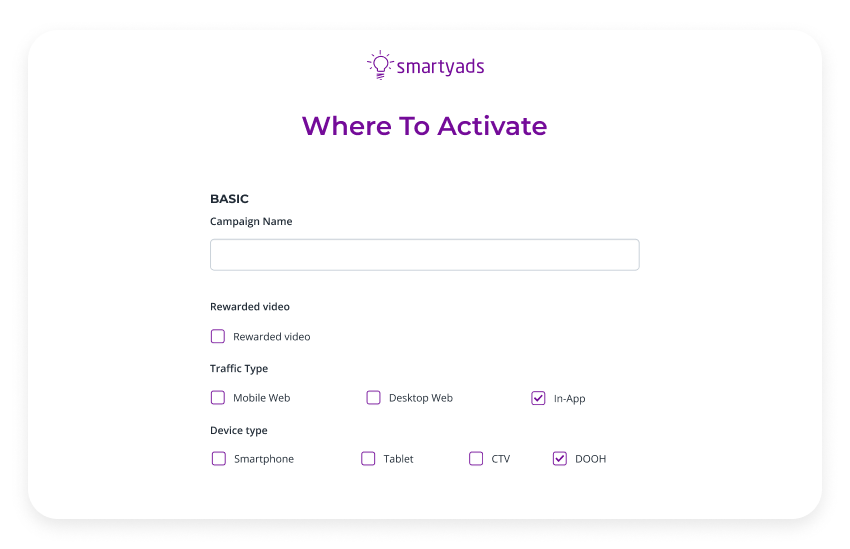
3) Run effective DOOH advertising campaigns
To sum up
DOOH as a medium matures every day allowing more opportunities for creativity, targeting, and automation.
Programmatic DOOH is an essential part of DOOH advertising because it automates the process of media buying as well as ad serving on outdoor digital inventory. In other words, programmatic DOOH capabilities make the DOOH medium essentially simpler to advertise on and more effective in the end.
Ready to launch high-impact DOOH programmatic campaigns? Time to register at SmartyAds DSP.

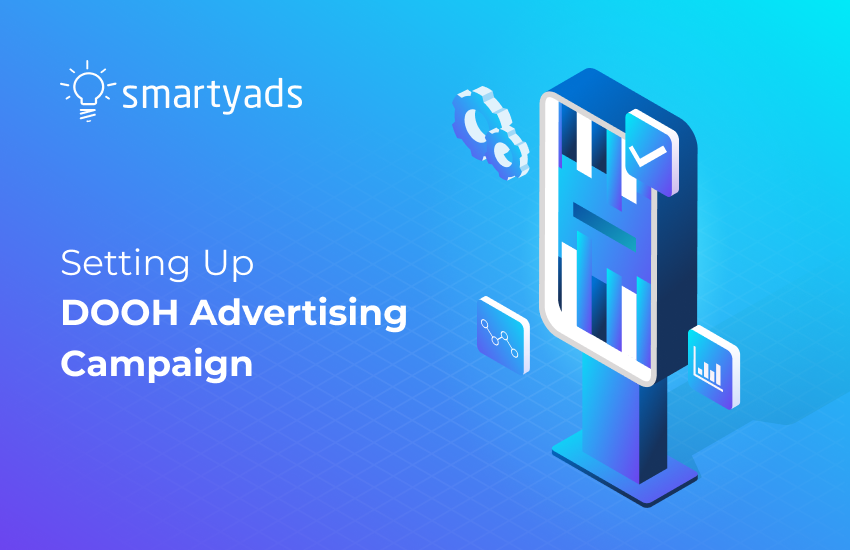


.webp)
